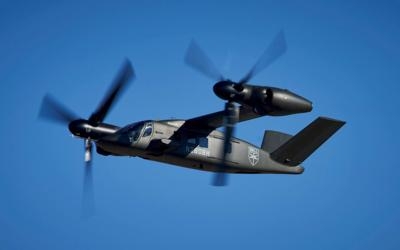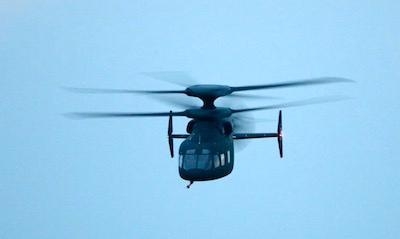Bell to Receive $7-Billion FLRAA Award
Sikorsky’s protest of the awarding of the U.S. Army’s Future Long Range Assault Aircraft (FLRAA) contract to rival Bell Helicopters has been denied by the U.S. Government Accountability Office (GAO). The dispute’s resolution affords Bell opportunity to get the program—worth a potential $7-billion—underway.

In its decision, handed down on Thursday, 06 April 2023, the GOA set forth: “In denying the protest, GAO concluded that the Army reasonably evaluated Sikorsky’s proposal as technically unacceptable because Sikorsky failed to provide the level of architectural detail required by the RFP [Request for Proposal]. GAO also denied Sikorsky’s various allegations about the acceptability of Bell’s proposal, including the assertion that the agency’s evaluation violated the terms of the solicitation or applicable procurement law or regulation. Finally, GAO dismissed Sikorsky’s additional arguments on the basis that Sikorsky was no longer an interested party to further challenge the procurement.”
On 05 December 2022, in a controversial decision disparaged by some in the aerospace and defense communities, Bell’s V-280 Valor tiltrotor beat out the joint Sikorsky-Boeing Defiant X coaxial rigid rotor helicopter.
Sikorsky disputed the Department of Defense’s (DOD) decision, filing a formal protest vis-à-vis the award’s outcome with GAO in late December 2022. Sikorsky argued in part: “ … data and discussions lead us to believe the proposals were not consistently evaluated to deliver the best value in the interest of the Army, our soldiers, and American taxpayers.”

In a joint statement following the GOA’s assertion of Bell’s retention of the FLRAA contract, Sikorsky and Boeing remarked: “We remain confident the Lockheed-Martin, Sikorsky, and Boeing team submitted the most capable, affordable, and lowest-risk Future Long-Range Assault Aircraft solution. We will review the GAO’s decision and determine our next steps.”
While the GAO has yet to release the entirety of its decision pertaining to the FLRAA contract, a summary of the report alleged Sikorsky’s protest had been based on the contention that its proposal was deemed unacceptable across several categories, to include “the engineering design and development evaluation factor, architecture subfactor, which ultimately rendered the proposal ineligible for award.”
The GAO FLRAA report summary further states: “Sikorsky also argued that the agency should have found Bell’s proposal to be unacceptable. … Finally, Sikorsky challenged the agency’s evaluation under the engineering design and development factor and the product supportability factor; the cost/price evaluation; and the best-value tradeoff decision.”

The initial provisions of the FLRAA deal stand to earn Bell up to $1.3-billion. The contract, as previously stated, could total as much as $7-billion were the Pentagon to pick up the entirety of its options—which include delivery of prototype aircraft and the first lot of low-rate initial production specimens.
In a statement of its own, Bell opined: “This decision validates the U.S. Army’s historic choice to modernize its air assault fleet with the flight-proven speed, range, and versatility delivered by Bell’s V-280 Valor. The Army followed a deliberate process throughout the competition, and we are excited to get to work as the Army’s partner in modernizing its aviation fleet.”
U.S. Army acquisition official Doug Bush disclosed in December 2022 that the service had factored a potential protest of the award into its planned program timeline.
The decision to award the FLRAA contract to Bell has drawn particular interest from lawmakers in Sikorsky’s home state of Connecticut. Senator Chris Murphy (Democrat, Connecticut) stated: “The Army’s decision to award the contract to Bell, even though its product is reportedly WAY more expensive than the Sikorsky product, is going to end up bilking American taxpayers.”
In a subsequent social media post, Murphy reported the Army—on four separate occasions—has declined Congress’s request for a briefing on the FLRAA award.
Sikorsky’s contention that the Army’s selection of Bells’ tiltrotor design fails to serve the best interests of America’s warfighters and taxpayers is shared by a number of military and aviation analysts—the bulk of whom cite the protracted development and difficult safety record of Boeing-Bell’s V-22 Osprey tiltrotor.
The V-22’s development spanned 15-years, ran 61-percent over-budget, and was involved in the loss of 23 US Marines.

In 2002, Brookings Institute senior fellow Michal E. O’Hanlon said of the V-22: “Its production costs are considerably greater than for helicopters with equivalent capability, specifically, about twice as great as for the CH-53E, which has a greater payload and an ability to carry heavy equipment the V-22 cannot ... an Osprey unit would cost around $60-million to produce, and $35 million for the helicopter equivalent.”
Adjusted for inflation, sixty-million 2002 dollars equals a kingly $100,355,742 in 2023.
To date, U.S. military V-22s have suffered 14 total hull losses and numerous additional accidents and incidents resulting in a total of 51 fatalities and 49 serious injuries. What’s more, in 2019—12-years after the V-22’s official entry into U.S. military service—the Osprey’s mission-ready rate was 52-percent.
 ANN's Daily Aero-Term (10.31.25): Minimum Sector Altitude [ICAO]
ANN's Daily Aero-Term (10.31.25): Minimum Sector Altitude [ICAO] ANN's Daily Aero-Linx (10.31.25)
ANN's Daily Aero-Linx (10.31.25) NTSB Final Report: Airbus A321-271N (A1); Cessna 172N (A2)
NTSB Final Report: Airbus A321-271N (A1); Cessna 172N (A2) ANN FAQ: Follow Us On Instagram!
ANN FAQ: Follow Us On Instagram! Airborne 10.30.25: Earhart Search, SpaceX Speed Limit, Welcome Back, Xyla!
Airborne 10.30.25: Earhart Search, SpaceX Speed Limit, Welcome Back, Xyla!






